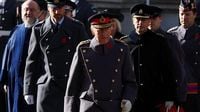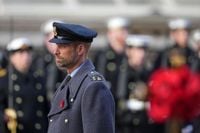Under the crisp November sun, London’s Whitehall was transformed into a solemn sea of reflection and remembrance on November 10, 2025. King Charles III, dressed in his field marshal uniform with a ceremonial coat, led thousands in Britain’s annual Remembrance Day service at the Cenotaph memorial. The occasion, steeped in tradition and emotion, marked the 80th anniversary of the end of the Second World War, but its resonance was keenly felt against the backdrop of ongoing global conflicts, including the nearly four-year-old war in Ukraine.
At precisely 11 a.m., Parliament’s Big Ben tolled, and a hush fell over the assembled crowd. Military personnel, veterans, politicians, and members of the public—many wearing the iconic red paper poppies on their lapels—stood shoulder to shoulder in a two-minute silence. The stillness was broken by a single artillery blast, followed by the haunting notes of "The Last Post" sounded by the Royal Marines buglers, a tradition that has echoed through the decades since the Cenotaph was first erected more than a century ago to honor the British and allied troops killed in World War I.
King Charles, 76, appeared visibly moved as he approached the monument. His eyes glistened with tears, a moment not lost on the crowd or the millions watching from afar. According to The Telegraph, the King was often captured in deep reflection, particularly as he saluted the monument. Social media buzzed with reactions: "Close-ups of His Majesty showed his eyes welling up with tears. An emotional moment for him no doubt," one observer noted. Another agreed, "King Charles looked so devastatingly sad." Body language expert Judi James, speaking to Express, observed, "His eyes looked red-rimmed despite the relatively mild weather, and they appeared to glisten with tears throughout. His expression appeared reflective, but his features moved about to suggest suppressed emotions. He seemed to be swallowing heavily and his mouth moved a lot as he looked up at the Cenotaph."
The King was not alone in his vigil. Prince William, dressed in Royal Air Force uniform as a Wing Commander, followed his father in laying a wreath on the simple Portland stone monument inscribed with the words "the glorious dead." Other members of the royal family participated, including Prince Edward, the Duke of Edinburgh, while Queen Camilla, Princess Kate, the Duchess of Edinburgh, the Duke of Kent, and the Duke and Duchess of Gloucester watched from the Foreign Office balcony overlooking the memorial. Many noted the absence of Princess Anne, who was in Australia for a royal tour marking the centenary of the Royal Australian Corps of Signals, of which she is Colonel-in-Chief. Prince Andrew, meanwhile, was notably missing after being formally stripped of his royal titles amid ongoing controversies, as reported by Royal Insider and AP.
The service was not only a gathering of British dignitaries. Representatives from across the Commonwealth, including Caribbean nations such as Antigua and Barbuda, Barbados, St Kitts and Nevis, St Vincent and the Grenadines, Trinidad and Tobago, Dominica, Belize, as well as the Overseas Territories of the British Virgin Islands and Anguilla, laid wreaths to honor their countrymen who served and sacrificed in the World Wars. Diplomats from these nations stood alongside British leaders, a testament to the enduring bonds forged in conflict and remembrance.
Prime Minister Sir Keir Starmer, laying his own wreath, spoke to the significance of the day and the enduring legacy of those who served. He remarked, "This Remembrance Sunday, we pause as a nation to honour all those who have served our country as we reflect on the extraordinary courage of our Armed Forces in the world wars and subsequent conflicts, whose service secured the freedoms we cherish today." Marking the 80th anniversary, he added, "Such sacrifice deserves more than silence, which is why this government remains committed to supporting veterans, their families and those who serve. Today, we remember, and we renew our promise to uphold the values they fought for."
The ceremony was rich in symbolism and tradition. Many of the wreaths were made of scarlet poppies, a flower immortalized by the poem "In Flanders Fields" and now an enduring symbol of remembrance in Britain and across the Commonwealth. The poppy’s presence was everywhere: on lapels, in bouquets, and in the hands of the youngest attendees, connecting generations through shared memory.
Following the wreath-laying, a military band struck up as some 10,000 military veterans, their medals gleaming in the sunlight, marched past the Cenotaph. The crowd erupted in applause, especially for the dwindling number of World War II veterans present. Among them was 101-year-old Sid Machin, one of the last surviving "Chindit" soldiers from the Burma campaign, who as a young man landed behind enemy lines in a glider as part of a special forces unit. Donald Poole, another 101-year-old veteran who served as a Royal Army Ordnance Corps explosives handler, reflected, "It is a great honor to be able to pay tribute to the poor souls who have died in all conflicts. I know how lucky I am to still be here thanks to all those who have fought and served, past and present. I also want to pay tribute to the civilian services who suffered during the Second World War, particularly the fire service, who saved so many lives during the Blitz—and many of whom lost their own."
The annual ceremony is always held on the nearest Sunday to November 11, the anniversary of the end of World War I in 1918. Similar services took place across Britain and at U.K. military bases overseas, underscoring the national and international scope of remembrance. Yet this year’s event felt particularly poignant. As AP noted, the shadow of war in Ukraine loomed large, a reminder that peace and security remain fragile. Britain, like many NATO allies, has responded by increasing its defense spending, pledging to reach 3.5% of GDP by 2035.
This year’s Remembrance Day service was more than a ritual—it was a vivid demonstration of collective memory, unity, and the enduring cost of conflict. The sight of King Charles, fighting back tears as he honored the fallen, captured a nation’s gratitude and grief. The applause for the veterans, the poppies bright against black coats, the silence broken only by the bugle’s call—all these moments wove together to create a tapestry of remembrance that few who attended, or watched from afar, will soon forget.
As the crowds dispersed and the last notes of the band faded, the promise made by leaders and citizens alike lingered in the air: to remember, to honor, and to uphold the values for which so many gave their lives.


